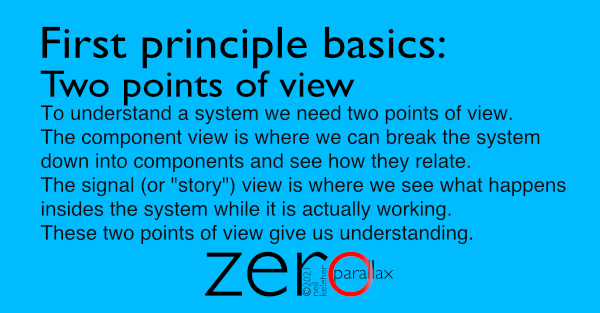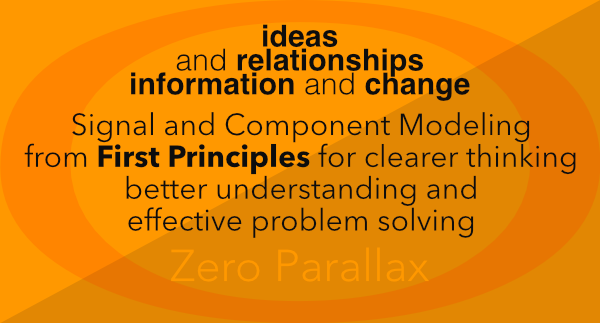Working from first principles

Working from first principles is, in part, about differentiating complex systems, breaking them down into component parts so that we can understand how they work. The differentiating is how we model the system. And it provides a framework for two potential points of view when modelling the system.
Two points of view for understanding a system
When trying to understand what a system does, there are two main point of view.
The component view
The component (or "architectural") view of a system is where we can see and recognize the individual component parts. We can see the parts and how they relate. Depending on the system, we may be able to take it apart and reassemble it. This is one way of arriving at the component view.
An important aspect when disassembling and reassembling is having a fixed sequence. This provides a framework for showing how the parts relate to each other and the system as a whole.
A general term for the component parts in this view is [idea].
A term for any two related or connected parts is [relationship].
Because this view involves breaking down the system and putting it back together, it's possible to view parts in relative isolation and also possible to see possibilities for these parts (the [ideas]) outside the context of the current system.
What we can then see if the potential for the various component parts or [ideas]
The signal view
The signal view of a system is a view taken while it is actually working. A key point is that we aren't looking at the whole system while it is working. Instead, we follow one particular signal as it travels from component to component.
The signal view is the eventual summation of all possible signals through the system in any possible mode.
A strict definition of a signal is that it is something that is transmitted between any two, and only two, components. That being said, the same term or name can be used to refer to a series of signals. Where a more strict definition of a series of signals is required, the term "story" can be used.
A story is a series of connected signals.
Where the component [idea] view helps us to see and understand how the parts related, and also the potential of the component parts, the signal [relationship] view is where we understand how the system works in a specific configuration.
Working from first principles is about how we think
When working from first principles, what matters is how we think. We use thinking, or analytical thought to divide a system into ideas and signals. We then assemble these ideas and signals into a model within our consciousness. You could think of this as happening in "imaginary space". Because of this, both the ideas and the relationships that we come up with are "imaginary." They are imaginary representations. As a result, we can choose how we define them. And we can choose to redefine them when necessary.
The things that we use to define ideas and relationships are [limits].
Working from first principles is a trial and error process
Because ideas, relationships and limits are all imaginary constructs, working from first principles can be a trial and error process till we find the ideas and relationships that give us the best results based on what we are trying to do.
The power of first principles
The fact that working from first principles involves so much trial and error is actually also its strength. When we redefine ideas and relationships we create a change. This change is geared towards understanding what we are working with.
With practice working with change (by creating it ourselves) we can get better at dealing with change in general.
